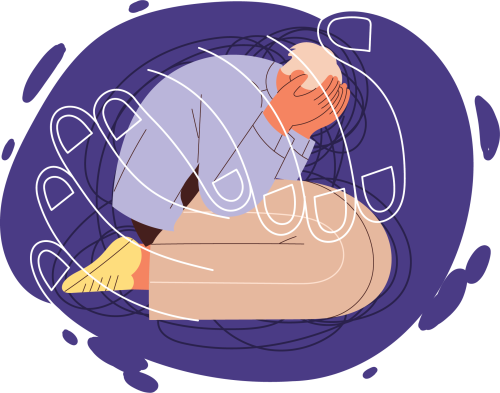Beyond Burnout: The Hidden Cost of Sanctuary Trauma on Mental Health and Organizational Culture
When people dedicate their lives to serving others—whether as healthcare providers, first responders, or veterans—they trust that their institutions will support them. But what happens when those institutions fail? When the very systems meant to provide safety and care instead become sources of harm? This is the essence of sanctuary trauma—a sense of betrayal that occurs when individuals expect their organizations to protect their well-being, only to encounter indifference, neglect, or bureaucratic obstacles.
The Origins of Sanctuary Trauma
The term “sanctuary trauma” was first introduced by Dr. Steven Silver in the 1980s to describe the experience of veterans returning from combat, expecting support from the institutions meant to help them reintegrate, only to be met with bureaucracy, lack of resources, or societal indifference. This betrayal deepened their existing trauma, hindering their recovery. Over time, the concept expanded to encompass other high-risk professions, such as healthcare and emergency response, where individuals often face institutional failures that leave them unsupported.

The Sanctuary® Model was developed in response to these challenges. Created by Dr. Sandra Bloom and her team in the 1980s, the model focuses on fostering safety and recovery by building a trauma-informed community within organizations. It recognizes that trauma affects both those receiving care and those providing it. The Sanctuary Model has since been adapted for various settings, including residential treatment, juvenile justice, and drug and alcohol treatment, as well as shelters. It aims to transform organizational culture by integrating trauma-informed principles, moving beyond rigid protocols to a dynamic, ongoing process. The model comprises three key components: theoretical philosophies, a shared trauma-informed language represented by the acronym S.E.L.F. (safety, emotion management, loss and future), and practical tools provided in the Sanctuary Tool Kit. Through these components, the Sanctuary Model seeks to mitigate the harmful effects of adversity and stress, creating environments that support both clients and organizational staff.
A Growing Concern
Sanctuary trauma isn’t a new concept, but it is becoming more prevalent in today’s unpredictable and ever-changing environment. High-stress professions are particularly affected as systems are stretched thin, organizations face chronic understaffing, policies continually change, and employees feel their needs for safety and support are not being met. Additionally, heavy administrative demands often leave employees unable to focus on their core responsibilities, making it difficult to do their jobs effectively. Here are some key factors that contribute to sanctuary trauma in organizations:
 Leadership & Culture Issues: Toxic leadership, characterized by leaders who lack emotional intelligence, dismiss employee concerns, or prioritize performance over well-being, can create environments where employees feel unsafe. In such settings, the lack of psychological safety can exacerbate the issue, as employees may fear retaliation for speaking up and, as a result, suppress concerns about workplace stress, mistreatment, or burnout. Additionally, when organizations normalize overwork and celebrate sacrifice as a badge of honor, it sends a message that employee well-being is secondary, leading to an environment where employees’ needs are ignored.
Leadership & Culture Issues: Toxic leadership, characterized by leaders who lack emotional intelligence, dismiss employee concerns, or prioritize performance over well-being, can create environments where employees feel unsafe. In such settings, the lack of psychological safety can exacerbate the issue, as employees may fear retaliation for speaking up and, as a result, suppress concerns about workplace stress, mistreatment, or burnout. Additionally, when organizations normalize overwork and celebrate sacrifice as a badge of honor, it sends a message that employee well-being is secondary, leading to an environment where employees’ needs are ignored.
 Organizational Policies & Practices: Bureaucratic barriers to support, such as complicated, slow, or dismissive HR processes, can make employees feel unheard or invalidated when they seek help. Workplace policies regarding time off are another critical factor; organizations that do not offer adequate or flexible time off during difficult life experiences—such as the loss of a family member—or after critical incidents that have a significant emotional impact, can further isolate employees. When employees feel that they must return to work immediately following such events or are not given sufficient time to heal, it deepens the sense that the organization prioritizes productivity over the well-being of its people. Furthermore, when health benefits are merely a checkbox with no true culture of well-being, employees may feel that their needs are not genuinely supported. For example, offering health benefits without providing access to adequate mental health care, or conducting employee surveys and gathering feedback but never implementing it. Additionally, organizations that fail to implement trauma-informed practices may unintentionally re-traumatize employees by not acknowledging the impact of trauma on their well-being. This lack of awareness can be compounded by inadequate mental health resources, where insufficient or inaccessible support services, such as underfunded Employee Assistance Programs (EAPs), leave employees feeling abandoned when they turn to the organization for help.
Organizational Policies & Practices: Bureaucratic barriers to support, such as complicated, slow, or dismissive HR processes, can make employees feel unheard or invalidated when they seek help. Workplace policies regarding time off are another critical factor; organizations that do not offer adequate or flexible time off during difficult life experiences—such as the loss of a family member—or after critical incidents that have a significant emotional impact, can further isolate employees. When employees feel that they must return to work immediately following such events or are not given sufficient time to heal, it deepens the sense that the organization prioritizes productivity over the well-being of its people. Furthermore, when health benefits are merely a checkbox with no true culture of well-being, employees may feel that their needs are not genuinely supported. For example, offering health benefits without providing access to adequate mental health care, or conducting employee surveys and gathering feedback but never implementing it. Additionally, organizations that fail to implement trauma-informed practices may unintentionally re-traumatize employees by not acknowledging the impact of trauma on their well-being. This lack of awareness can be compounded by inadequate mental health resources, where insufficient or inaccessible support services, such as underfunded Employee Assistance Programs (EAPs), leave employees feeling abandoned when they turn to the organization for help.
 Workplace Culture & Peer Dynamics: Toxic workplace culture, especially in environments divided along political and ideological lines, can be particularly harmful to individuals experiencing trauma. When someone’s struggles don’t align with the dominant culture, they may be dismissed, mocked, or ignored, deepening their distress and pushing them further into isolation. Stigma around mental health compounds this issue, creating an environment where seeking support is seen as a sign of weakness, leading employees to avoid reaching out and suffer in silence. The situation worsens when bullying, harassment, or discrimination are ignored or tolerated, causing employees to lose trust in the organization’s ability to protect them. Additionally, favoritism and inequity—evident in unequal treatment in promotions, workloads, or disciplinary actions—further erode trust and reinforce feelings of alienation, ultimately undermining workplace cohesion and employee well-being.
Workplace Culture & Peer Dynamics: Toxic workplace culture, especially in environments divided along political and ideological lines, can be particularly harmful to individuals experiencing trauma. When someone’s struggles don’t align with the dominant culture, they may be dismissed, mocked, or ignored, deepening their distress and pushing them further into isolation. Stigma around mental health compounds this issue, creating an environment where seeking support is seen as a sign of weakness, leading employees to avoid reaching out and suffer in silence. The situation worsens when bullying, harassment, or discrimination are ignored or tolerated, causing employees to lose trust in the organization’s ability to protect them. Additionally, favoritism and inequity—evident in unequal treatment in promotions, workloads, or disciplinary actions—further erode trust and reinforce feelings of alienation, ultimately undermining workplace cohesion and employee well-being.
 Compounding Trauma: Frontline professionals and veterans are already facing unprecedented burnout due to their exposure to repeated trauma in high-stress professions like healthcare, emergency response, social work, and firefighting. Burnout is further exacerbated by a failure to support survivors of workplace trauma. Organizations that do not provide adequate support after critical incidents, such as violence, patient deaths, or firefighter line-of-duty injuries, only deepen trauma rather than helping to resolve it. In addition, when a person seeks help, they often encounter bureaucratic barriers, budget cuts, or unsympathetic leadership, deepening their sense of betrayal and compounding their distress. This lack of support, coupled with understaffing and resource scarcity, forces employees to do more with fewer resources, escalating frustration and burnout.
Compounding Trauma: Frontline professionals and veterans are already facing unprecedented burnout due to their exposure to repeated trauma in high-stress professions like healthcare, emergency response, social work, and firefighting. Burnout is further exacerbated by a failure to support survivors of workplace trauma. Organizations that do not provide adequate support after critical incidents, such as violence, patient deaths, or firefighter line-of-duty injuries, only deepen trauma rather than helping to resolve it. In addition, when a person seeks help, they often encounter bureaucratic barriers, budget cuts, or unsympathetic leadership, deepening their sense of betrayal and compounding their distress. This lack of support, coupled with understaffing and resource scarcity, forces employees to do more with fewer resources, escalating frustration and burnout.
 Erosion of Trust: Conflicts between an organization’s mission and its reality can lead to deep disillusionment among employees. Many join with the belief that they will make a meaningful difference, only to become frustrated when systemic issues go unaddressed. Continual organizational politics and policy changes have led to the erosion of institutional trust. Many professionals, including veterans and first responders, no longer trust their organizations to support them when they need it most. This lack of faith makes it harder for employees to reach out for help, as they fear their concerns will be dismissed or politicized.
Erosion of Trust: Conflicts between an organization’s mission and its reality can lead to deep disillusionment among employees. Many join with the belief that they will make a meaningful difference, only to become frustrated when systemic issues go unaddressed. Continual organizational politics and policy changes have led to the erosion of institutional trust. Many professionals, including veterans and first responders, no longer trust their organizations to support them when they need it most. This lack of faith makes it harder for employees to reach out for help, as they fear their concerns will be dismissed or politicized.
 Public Scrutiny: Healthcare workers, firefighters, law enforcement officers, and veterans are under more public scrutiny than ever, facing increased pressure and heightened expectations in their roles. Healthcare workers, especially during the COVID-19 pandemic, have been at the forefront of intense public debate regarding policies, resources, and patient care. Similarly, firefighters are scrutinized during large-scale natural disasters, with public focus on decisions made under extreme stress, as well as on the unpredictable forces of nature. Law enforcement officers are constantly under the microscope, particularly in cases involving the use of force, which sparks public outcry and calls for reform. Veterans, too, face scrutiny regarding their reintegration into civilian life, with attention often placed on the challenges they face, such as mental health issues or homelessness. This public scrutiny, coupled with the inherent stresses of these demanding professions, can exacerbate the emotional toll on these individuals, affecting their mental health and sense of support from society. Seeking mental health support is already difficult, but when it’s met with fear of backlash, job loss, or stigma, many simply choose to suffer in silence. The result? Higher rates of PTSD, divorce, depression, and substance use.
Public Scrutiny: Healthcare workers, firefighters, law enforcement officers, and veterans are under more public scrutiny than ever, facing increased pressure and heightened expectations in their roles. Healthcare workers, especially during the COVID-19 pandemic, have been at the forefront of intense public debate regarding policies, resources, and patient care. Similarly, firefighters are scrutinized during large-scale natural disasters, with public focus on decisions made under extreme stress, as well as on the unpredictable forces of nature. Law enforcement officers are constantly under the microscope, particularly in cases involving the use of force, which sparks public outcry and calls for reform. Veterans, too, face scrutiny regarding their reintegration into civilian life, with attention often placed on the challenges they face, such as mental health issues or homelessness. This public scrutiny, coupled with the inherent stresses of these demanding professions, can exacerbate the emotional toll on these individuals, affecting their mental health and sense of support from society. Seeking mental health support is already difficult, but when it’s met with fear of backlash, job loss, or stigma, many simply choose to suffer in silence. The result? Higher rates of PTSD, divorce, depression, and substance use.
What Needs to Change
Organizations must step up to prevent sanctuary trauma, which is preventable with the right leadership and commitment. Creating environments where employees feel psychologically safe is essential. This includes instituting trauma-informed practices that foster a safe, non-judgmental atmosphere, where employees’ experiences are validated and flexible support options are offered to meet individual needs. Additionally, organizations must break down barriers to mental health support by making it easy, confidential, and stigma-free. Cultivating a culture of trust is also crucial, ensuring employees know they will be heard and supported. Everyone in the organization must be held accountable for ensuring that policies and practices prioritize well-being, while investments in resources that support resilience, such as peer support programs and trauma-informed leadership training, are vital to long-term success.

For those on the front lines—firefighters, healthcare providers, veterans, and emergency responders—this isn’t just about job satisfaction; it’s about survival. These individuals are often called to serve for years or even decades, enduring repeated exposure to trauma while balancing the emotional and physical toll of their work. Sanctuary trauma, a form of betrayal, can leave lasting scars that affect not only their well-being but also their ability to continue in these demanding roles. When organizations fail to acknowledge the cumulative stress and trauma faced by these workers, the effects can be profound. However, with the right leadership and a true organizational commitment to support and well-being, institutions can create environments that prioritize healing, resilience, and long-term success. And they must—especially for those who dedicate their lives to these high-stakes, life-saving positions.
References
Centers for Disease Control and Prevention (CDC). (2024, April 15). Supporting mental health in the workplace. NIOSH Science Blog. Retrieved February 4, 2025, from https://blogs.cdc.gov/niosh-science-blog/2024/04/15/workplace-mental-health-resources/
Mission Roll Call. (2023, January 11). What are the barriers to healthcare for veterans? Retrieved February 4, 2025, from https://missionrollcall.org/veteran-voices/articles/what-are-the-barriers-to-healthcare-for-veterans/
Fried, A. L., & Fisher, C. B. (2016). Moral stress and job burnout among frontline staff conducting clinical research on affective and anxiety disorders. Professional Psychology: Research and Practice, 47(3), 171–180. https://doi.org/10.1037/pro0000060
OpenAI. (2024). ChatGPT (Version 4) [AI language model]. Assisted in generating ideas and editing content for improved flow in the blog post on sanctuary trauma. Retrieved February 4, 2024, from https://chat.openai.com
Rasool SF, Wang M, Tang M, Saeed A, Iqbal J. How Toxic Workplace Environment Effects the Employee Engagement: The Mediating Role of Organizational Support and Employee Wellbeing. Int J Environ Res Public Health. 2021 Feb 26;18(5):2294. https://pmc.ncbi.nlm.nih.gov/articles/PMC7956351/
Silver, S. M. (1987). An inpatient program for post-traumatic stress disorder: Context as treatment. In Trauma and its wake (1st ed., p. 19). Routledge.
Substance Abuse and Mental Health Services Administration (SAMHSA). (2018, May). First responders: Behavioral health concerns, emergency response, and trauma. Retrieved February 4, 2025, from https://www.samhsa.gov/sites/default/files/dtac/supplementalresearchbulletin-firstresponders-may2018.pdf
The MacKillop Institute. (n.d.). Origins of the Sanctuary model. Retrieved February 4, 2025, from https://www.mackillopinstitute.org.au/resources-and-stories/Origins-of-the-Sanctuary-model/
Blog Post Tags:
Related Blog Posts
Related Learning Labs
Related Resources
.
- Buscar Tratamiento de Calidad para Trastornos de uso de Sustancia (Finding Quality Treatment for Substance Use Disorders Spanish Version)
- Finding Quality Treatment for Substance Use Disorders
- Focus On Prevention: Strategies and Programs to Prevent Substance Use
- Monthly Variation in Substance Use Initiation Among Full-Time College Students
- The National Survey on Drug Use and Health (NSDUH) Report: Monthly Variation in Substance Use Initiation Among Adolescents








